Mount Rainier, a majestic snow-capped volcano, proudly stands against the clear blue sky of Washington State, USA. More than just a symbol of the Pacific Northwest, Rainier is a sacred destination for those who dream of conquering heights. Rising over 14,410 feet (4,392 meters) above sea level, this “roof of Washington” challenges every limit, rewarding those who dare to face it with breathtaking natural scenery and a unique climbing experience. Climbing Mount Rainier is not just a physical adventure, but also a journey of self-discovery, immersion in wild nature, and feeling the grandeur of creation.
Established in 1899, Mount Rainier National Park embraces this magnificent volcano and its diverse surrounding ecosystem. It not only preserves unspoiled natural beauty but is also an ideal destination for those seeking peace and unique outdoor experiences. From vibrant alpine meadows in summer, lush green old-growth forests year-round, to majestic glaciers and cascading waterfalls, Mount Rainier holds countless wonders waiting for visitors to explore.
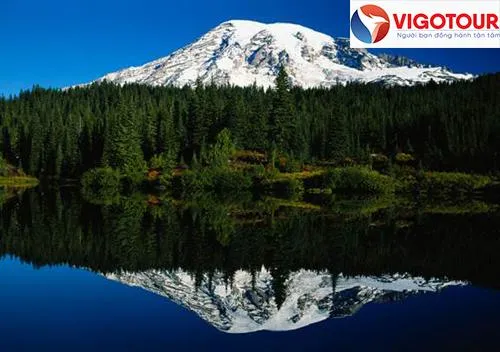
Mount Rainier National Park: Discovering Diverse Beauty
Mount Rainier National Park is not only famous for Mount Rainier volcano but also a treasure trove of biodiversity. Covering an area of over 369 square miles (950 km²), the national park includes various ecosystems, from temperate coniferous forests, montane rainforests, to alpine meadows and glaciers. This diversity creates a rich and attractive natural tapestry, attracting millions of visitors each year.
Rich Ecosystems: The national park is home to hundreds of wildlife species, including black bears, black-tailed deer, elk, foxes, squirrels, and various birds. Visitors can easily spot deer peacefully grazing by trails or playful squirrels darting among ancient trees. The flora is also incredibly diverse with thousands of wildflowers, shrubs, and trees, creating a vibrant tapestry of color throughout the seasons.
Spectacular Landscapes: Besides the majestic Mount Rainier, the national park boasts many other stunning natural landscapes. Narada Falls cascades from a height of nearly 164 feet (50 meters) into a deep ravine, creating a majestic and poetic scene. Reflection Lake is famous for its perfect reflection of Mount Rainier on the still water, especially beautiful in the early morning or late afternoon. Paradise and Sunrise meadows transform into brilliant flower carpets in the summer, attracting countless visitors to admire and photograph.
Historical Significance: The entire Mount Rainier National Park was recognized as a National Historic Landmark District in 1997, acknowledging its special historical and cultural values. The architectural structures within the national park, built in the rustic style characteristic of the National Park Service, harmonize with the natural landscape and bear a strong historical imprint.
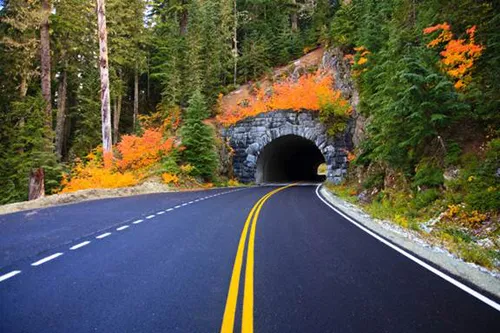
Journey to Conquer Mount Rainier: Challenges and Rewards
Climbing Mount Rainier is not an easy activity; it requires thorough preparation in terms of fitness, skills, and equipment. However, for those passionate about mountaineering and wanting to challenge themselves, this is an unmissable experience.
Difficulty and Climbing Routes: Mount Rainier is rated as a mountain of moderate to difficult difficulty, depending on the route and weather conditions. There are several climbing routes to the summit of Rainier, the most popular being the Camp Muir route via Glacier Vista. This route does not require complex ice climbing techniques but still demands good fitness and experience in hiking on high-altitude terrain. Other routes such as Emmons Glacier or Kautz Glacier are more challenging, requiring ice climbing skills and extensive experience.
Climbing Duration: The average climbing time for Mount Rainier is 2 to 3 days, depending on the route and the pace of the climbing group. The first day is usually spent approaching base camps on the mountain like Camp Muir (at an altitude of about 9,843 feet or 3,000 meters). The second day is summit day, usually starting in the middle of the night to ensure safety and time to descend before the weather worsens in the afternoon. The third day is for descending the mountain and returning to the starting point.
Preparing for the Climb: To ensure safety and success in climbing Mount Rainier, thorough preparation is crucial.
- Fitness: Climbing Mount Rainier requires good physical fitness, especially endurance and leg strength. You should exercise regularly before the trip, focusing on endurance-building exercises such as running, long-distance walking, stair climbing, and leg strength exercises.
- Skills: If you do not have ice climbing experience, take basic mountaineering training courses to master necessary skills such as using trekking poles, walking on ice, and using ropes safely.
- Equipment: Specialized mountaineering equipment is indispensable. You need to prepare enough warm, waterproof clothing, specialized mountaineering boots, gloves, hats, sunglasses, sunscreen, trekking poles, headlamps, mountaineering backpacks, warm sleeping bags, and enough food and water for the entire journey.
- Permits and Reservations: Climbing Mount Rainier requires a permit from Mount Rainier National Park. You need to book permits in advance, especially during peak season. If you plan to camp overnight on the mountain, you also need to make reservations for designated campsites.
- Weather Awareness: Weather on Mount Rainier can change very quickly and unpredictably. Monitor the weather forecast before and throughout your climb to be best prepared.
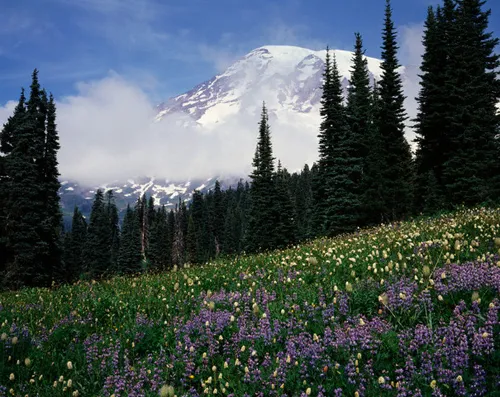
Experiencing the Mount Rainier Climb: Unforgettable Emotions and Memories
Climbing Mount Rainier is not only a physical challenge but also a meaningful spiritual journey. Overcoming difficulties, fatigue, and dangers, you will be rewarded with unforgettable experiences and emotions.
Magnificent Natural Scenery: From the summit of Mount Rainier, you will admire the panoramic view of Mount Rainier National Park and the surrounding area. Rolling mountain ranges, winding white glaciers, and blue lakes nestled among forests all create a magnificent and majestic natural painting. Especially on clear days, you can even see the city of Seattle and Puget Sound from the summit.
Sense of Conquest: Standing on the summit of Mount Rainier, after so much effort and striving, the feeling of bursting happiness and pride is indescribable. You have overcome your limits, conquering one of the highest and most beautiful mountains in the United States. This memory will stay with you for life and become a great source of motivation in future challenges.
Connection with Nature: Climbing Mount Rainier is a great opportunity to immerse yourself in wild nature, escape all the hustle and bustle, and enjoy the peace and tranquility of the mountains and forests. You will breathe in the fresh air, listen to birdsong, observe wildlife, and feel the vibrant life of nature around you.
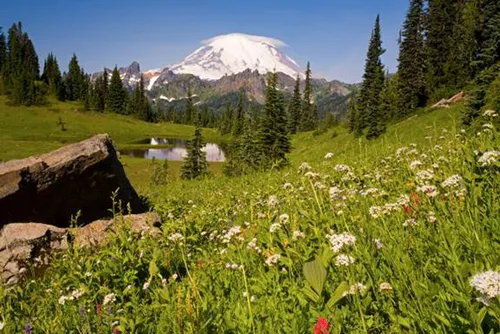
Tips and Notes for Climbing Mount Rainier
For a smooth and safe Mount Rainier climbing trip, keep in mind the following tips and advice:
- Choose the right climbing season: Summer (July to September) is the best time to climb Mount Rainier, when the weather is warm and less rainy. However, this is also peak season, so you need to book permits and accommodation in advance.
- Go with experienced climbers or join a guided climbing tour: If you have no climbing experience or are not familiar with Mount Rainier terrain, go with experienced climbers or join a guided tour with professional guides.
- Drink enough water and eat enough nutrients: Climbing consumes a lot of energy, so you need to drink enough water and eat enough nutrients to maintain health and stamina. Bring enough drinking water, energy-rich snacks like chocolate, energy bars, dried fruit, and nutritious lunches.
- Climb slowly and rest frequently: Do not try to climb too fast, climb slowly and rest frequently to avoid fatigue and altitude sickness.
- Pay attention to signs of altitude sickness: Altitude sickness is a serious issue when climbing high mountains. Pay attention to signs of altitude sickness such as headache, dizziness, nausea, shortness of breath, and descend immediately if you experience any symptoms.
- Protect the environment: Maintain general hygiene, do not litter, and comply with the regulations of Mount Rainier National Park to protect the wild natural environment.
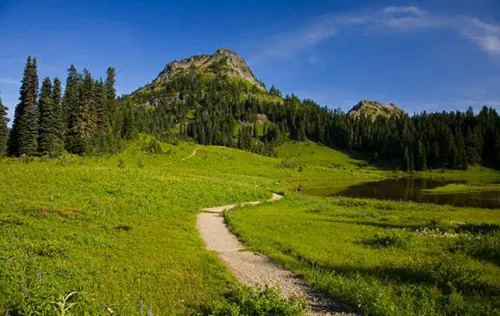
Conclusion
Climbing Mount Rainier is a memorable and challenging experience, offering you the opportunity to discover the majestic beauty of nature, conquer your limits, and create unforgettable memories. If you are a mountaineering enthusiast and looking for a real adventure, come to Mount Rainier National Park and conquer the roof of Washington. Surely, you will not be disappointed by the beauty and wonder of this magnificent volcano. Prepare thoroughly, plan in detail, and start your journey to conquer the summit!